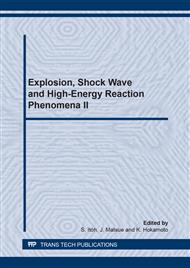p.114
p.120
p.126
p.132
p.138
p.144
p.150
p.154
p.160
Explosive Metalworking: Experimental and Numerical Modeling Aspects
Abstract:
The application of the High Energy Rate Forming (HERF) represents a new paradigm in the field of production of knowledge-based more components materials: furthermore, joining by plastic deformation of the materials is carried out directly, by high speed, high energy shock waves, without using energy transforming equipment as hydraulic presses etc. The energy sources of the HERF processes are either the electrical energy stored in capacitors or chemical energy stored in the high explosives. High explosives can be utilized for many metalworking techniques; however the three main types of explosive metalworking are: Explosive welding and cladding Explosive tubeforming Explosive compaction of powders and granulates. The present work briefly introduces the principles and practices of the three main types of the explosive metalworking techniques mentioned above and discusses aspects of their numerical simulation.
Info:
Periodical:
Pages:
138-143
Citation:
Online since:
July 2013
Price:
Сopyright:
© 2014 Trans Tech Publications Ltd. All Rights Reserved
Share:
Citation:


